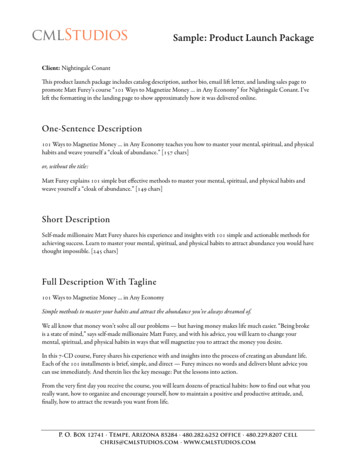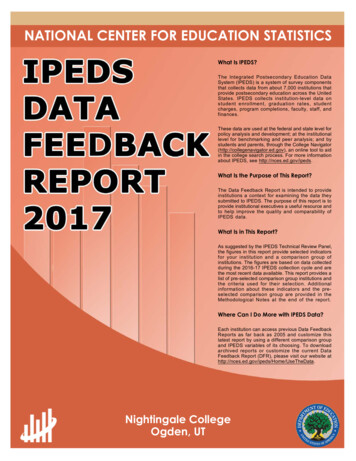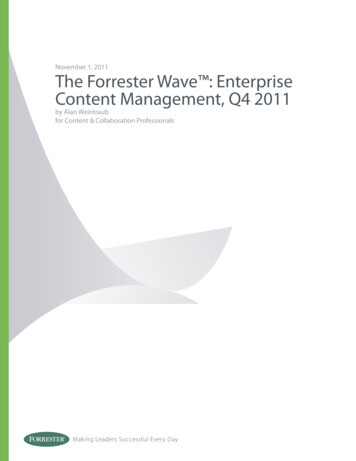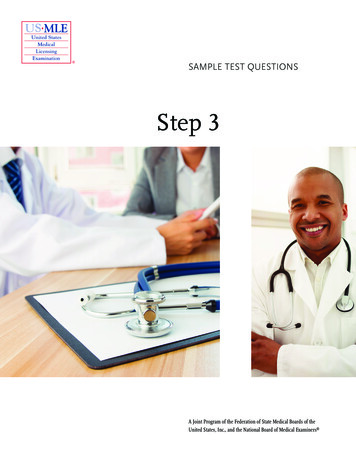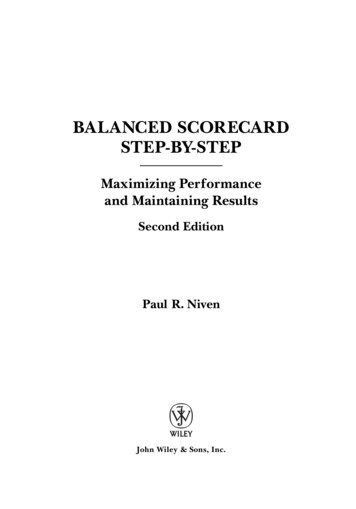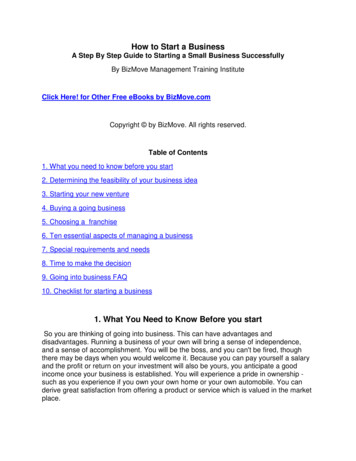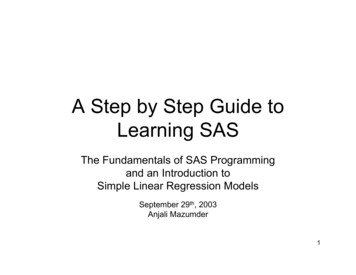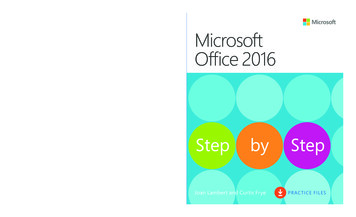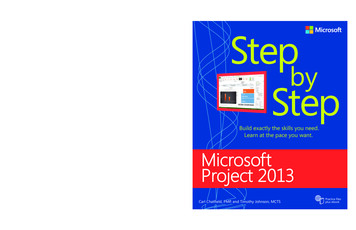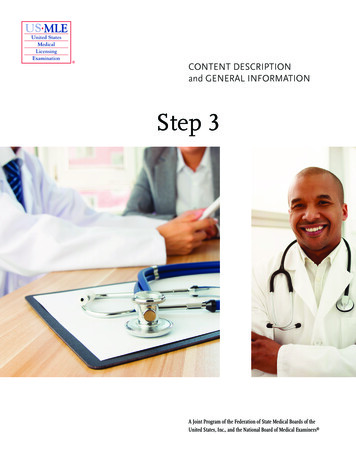
Transcription
CONTENT DESCRIPTIONand GENERAL INFORMATIONStep 3A Joint Program of the Federation of State Medical Boards of theUnited States, Inc., and the National Board of Medical Examiners
This booklet was updated November 2020.Copyright 2020 by the Federation of State Medical Boards of the United States, Inc. (FSMB), andNational Board of Medical Examiners (NBME ). All rights reserved. Printed in the United States ofAmerica. The United States Medical Licensing Examination (USMLE ) is a joint program of the FSMB andNBME.
CONTENTSIntroduction . 2Examination Format. 3Multiple-choice Items . 3Primum Computer-based Case Simulations . 4Purpose and Design of the Examination . 4Content Description . 5Content Outline . 5Table 1: Step 3 MCQ Test Content Specifications. 6Table 2: Step 3 CCS Test Content Specifications . 6Physician Tasks/Competencies . 7Table 3: Step 3 MCQ Physician Tasks/Compentencies Specifications . 7Table 4: Step 3 CCS Physician Tasks/Competencies Specifications . 8Step 3 MCQ Content and Competency Examples . 9Clinical Context of Step 3 . 13Site of Care. 13Clinical Encounter Frames . 15Primum Computer-based Case Simulations Overview . 16Introduction . 16Description . 16Case Interface and Format . 16The Patient. 18The Health Care Network and Facility . 18Evaluative Objectives and Assessment of Your Performance . 18Responsibilities of the Physician. 19Frequently Asked Questions . 21
INTRODUCTIONThis booklet will help you prepare for the Step 3 component of the United States Medical LicensingExamination (USMLE ).Sample test materials and tutorials, as well as other informational materials, are available at theUSMLE website (www.usmle.org).You should also review relevant descriptions that appear in the USMLE Bulletin of Information atwww.usmle.org/bulletin.IMPORTANT: The term item is used to describe a test question in any format. You must run the tutorial and practice materials to become familiar with the test softwareprior to your test date. The tutorial provided at the beginning of the Step 3 examination has fewer screens and lessdetailed information than the Step 3 practice materials tutorial on the USMLE website. The practice materials on the website include items with associated audio findings,pharmaceutical advertisements and scientific abstracts, and sequential item sets. Youshould become familiar with how these types of test items function before your test date.Please visit the USMLE website (www.usmle.org) often to view announcements, regarding changesin test delivery software, and to access updated practice materials. You must obtain the mostrecent information before taking any USMLE examination.The Step 3 examination consists of questions ("test items") presented in standard multiple-choicequestion (MCQ) formats, as described in the USMLE Step 3 Sample Test Questions booklet, andPrimum Computer-based Case Simulation (CCS), a test format that allows you to provide care fora simulated patient, as described on pages 16–26. The test items are divided into "blocks" andtest item formats may vary within each block. You may want to study the following descriptions ofitem formats before you run the practice test items.It is essential that you practice with the Primum Computer-based Case Simulation (CCS) formaton the computer prior to taking the examination. Experience shows that those who do notpractice with the format and mechanics of managing the patients in Primum CCS are likely to be ata disadvantage when taking the cases under standardized testing conditions. At the time of yourtest appointment, an optional CCS tutorial will be offered, but no practice cases will be available.2
EXAMINATION FORMATStep 3 consists of multiple-choice items and computer-based case simulations, distributedaccording to the content specifications. The examination material is prepared by examinationcommittees broadly representing the medical profession. The committees comprise recognizedexperts in their fields, including both academic and non-academic practitioners, as well asmembers of state medical licensing boards.Step 3 is a two-day examination. The first day of testing includes 232 multiple-choice items dividedinto 6 blocks of 38 to 39 items; 60 minutes are allotted for completion of each block of test items.The first-day test session is approximately 7 hours including 45 minutes of break time and a5-minute optional tutorial. Note that the amount of time available for breaks may be increased byfinishing a block of test items or the optional tutorial before the allotted time expires.There are approximately 9 hours in the test session on the second day. This day of testing includesa 5-minute optional tutorial followed by 180 multiple-choice items, divided into 6 blocks of 30items; 45 minutes are allotted for completion of each block of test items. The second day alsoincludes a 7-minute CCS tutorial. This is followed by 13 case simulations, each of which is allotted amaximum of 10 or 20 minutes of real time. A minimum of 45 minutes is available for break time.There is an optional survey at the end of the second day, which can be completed if time allows.Multiple-choice Items. One-best-answer formats are used. Items may stand alone or may begrouped together as a set of 2 to 3 items. Some sets are considered sequential and functiondifferently than other sets. It is important to study the descriptions in the USMLE Step 3 SampleTest Questions booklet. Test items present detailed clinical situations usually from the patient'sperspective. The presentation may be supplemented by one or more pictorials or audio. Assessingthe patient's situation in the context of his or her environment or family and clinical setting is animportant element of many Step 3 questions.Items with an associated pharmaceutical advertisement or scientific abstract are included in theexamination. Each pharmaceutical advertisement or scientific abstract will appear as a 2- or 3-itemset; you will see no more than 6 of these item sets in the examination.Items written in chart/tabular format are also included on the examination. Test items using thechart/tabular format are designed to resemble patient charts but are not intended to be an exactrepresentation of a patient chart. The chart/tabular format is used to provide patient informationin clearly marked sections. It is meant to provide information in list instead of paragraph form inorder to facilitate ease of reviewing information relevant to the accompanying question. Familiarmedical abbreviations may be used within chart/tabular format items.During the time allotted to complete the test items in a block, you may answer the items in anyorder (excluding sequential item sets), review responses, and change answers. After exiting ablock, no further review of items or changing of answers within that block is possible. Practicingwith the multiple-choice items on the USMLE website (www.usmle.org) will provide you with arealistic understanding of the computer interface and timing of the examination.3
A table of normal laboratory values for frequently ordered laboratory tests, including standardinternational conversions, will be available as an online reference when you take the examination.Primum Computer-based Case Simulations. You will manage one case at a time. Free-text entryof patient orders and the advancement of simulated time to execute those orders is the primarymeans of interacting with the format. Buttons and check boxes are used for ordering a physicalexamination, advancing the clock, changing the patient's location, reviewing previously displayedinformation, and obtaining updates on the patient.At the beginning of each case, you will see the clinical setting, starting simulated case time, andintroductory patient information. Photographs and sounds will not be provided. Normal orreference laboratory values will be provided with each report; some tests will be accompanied bya clinical interpretation. To manage patients using the Primum CCS software, it is essential thatyou complete the tutorial and sample cases provided on the USMLE website (www.usmle.org).PURPOSE AND DESIGN OF THE EXAMINATIONThe Step 3 examination devotes attention to the importance of assessing the knowledge and skillsof physicians who are assuming independent responsibility for providing general medical care topatients. The first day of the Step 3 examination is referred to as Foundations of IndependentPractice (FIP), and the second day is referred to as Advanced Clinical Medicine (ACM).Day 1Step 3 Foundations of Independent Practice (FIP)This test day focuses on assessment of knowledge of basic medical and scientific principlesessential for effective health care. Content areas covered include application of foundationalsciences; understanding of biostatistics and epidemiology/population health and interpretation ofmedical literature; and application of social sciences, including communication and interpersonalskills, medical ethics, systems-based practice, and patient safety. This test day also includescontent assessing knowledge of diagnosis and management, particularly focused on knowledge ofhistory and physical examination, making the diagnosis, and use of diagnostic studies. This test dayconsists solely of multiple-choice questions and includes some of the newer item formats, such asthose based on scientific abstracts and pharmaceutical advertisements.Day 2Step 3 Advanced Clinical Medicine (ACM)This test day focuses on assessment of the ability to apply comprehensive knowledge of healthand disease in the context of patient management and the evolving manifestation of disease overtime. Content areas covered include assessment of knowledge of diagnosis and management,particularly focused on prognosis and outcome; health maintenance and screening; therapeutics;and medical decision making. Knowledge of history and physical examination, diagnosis, and useof diagnostic studies also is assessed. This test day includes multiple-choice questions andcomputer-based case simulations.4
CONTENT DESCRIPTIONThe content description that follows is not intended as a curriculum development or study guide,but rather models the range of challenges that will be met in the actual practice of medicine. Itprovides a flexible structure for test construction that can readily accommodate new topics,emerging content domains, and shifts in emphasis. The categorizations and content coverage aresubject to change. Successful completion of at least one year of postgraduate training in aprogram accredited by the Accreditation Council for Graduate Medical Education or the AmericanOsteopathic Association should be helpful preparation for Step 3.Content OutlineAll USMLE examinations are constructed from an integrated content outline. The outline isavailable at the USMLE website (www.usmle.org/pdfs/usmlecontentoutline.pdf). Content isorganized according to general principles and individual organ systems. Test questions areclassified in one of 18 major areas, depending on whether they focus on concepts and principlesthat are important across organ systems or within individual organ systems. Most organ systemsare subdivided into normal and abnormal processes. They include subcategories of specific diseaseprocesses. In most instances, knowledge of normal processes is evaluated in the context of adisease process or specific pathology.Not all topics listed in the content outline are included in every USMLE examination. Overallcontent coverage is comparable between the various examinations for each Step that will beadministered.5
Table 1: Step 3 MCQ Test Content Specifications*SystemRange, %*General Principles of Foundational Science**1–3Immune System, Blood & Lymphoreticular System, and Multisystem6–8Processes/DisordersBehavioral Health4–6Nervous System & Special Senses8–10Skin & Subcutaneous Tissue4–6Musculoskeletal System5–7Cardiovascular System9–11Respiratory System8–10Gastrointestinal System6–8Renal/Urinary & Male Reproductive Systems4–6Pregnancy/Childbirth & Female Reproductive System & Breast7–9Endocrine System5–7Biostatistics & Epidemiology/Population Health & Interpretation of the Medical11–13LiteratureSocial Sciences: Communication Skills/Ethics/Patient Safety7–9* Percentages are subjec
you complete the tutorial and sample cases provided on the USMLE website (www.usmle.org). The Step 3 examination devotes attention to the importance of assessing the knowledge and skills of physicians who are assuming independent responsibility for providing general medical care to patients. The first day of the Step 3 examination is referred to as Foundations of Independent

